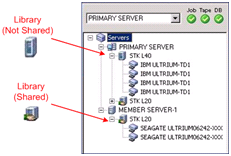To ensure that your Arcserve Backup installation functions properly, complete the following tasks:
- Open the Arcserve Backup Manager Console on a stand-alone server.
- Connect to the upgraded Arcserve Server using the virtual name.
- If you can successfully connect to the upgraded server, move the Arcserve cluster group to a different node.
Ensure that all Arcserve services started successfully.
Note: The Manager Console may stop responding intermittently while the cluster group is moving to a different node.
- Open the Server Admin.
Ensure that the domain directory tree displays the names of the primary server and all of the member servers in your ARCserve domain.
- Open the Job Status Manager.
Ensure that all data from the previous installation migrated to the new primary server. Arcserve Backup migrates information about jobs, logs, and user information from the previous servers to the new primary server.
- Open the Device Manager.
Ensure that the Device Manager detects all devices attached to the primary server and all member servers.
The following diagram illustrates the Device Manager window with a primary server with attached devices and a member server and attached device. The primary server is attached to a library that is not shared, and the member server is attached to a library that is shared.

If the Device Manager does not detect all of your devices, complete the following tasks:
- Ensure that the device is properly attached to the server.
- Ensure that you have proper device drivers installed.
- Configure the devices using Device Configuration.
If Arcserve Backup cannot detect the devices after you complete these tasks, contact Technical Support.
Note: For information about configuring devices, see the Administration Guide.
- Submit a simple backup job on a primary server.
Ensure that the job completes successfully.
If the job fails, perform the following troubleshooting tasks:
- From the Job Status Manager, review the Activity Log details for the job.
- If a job contains warning messages, error messages, or both, double-click the message to view a description of the problem and the steps that you can take to correct the problem.
- After you correct the problem, resubmit the job.
- Submit a simple backup job on a member server.
Ensure that the backup job completes successfully.
If the job fails, perform the following troubleshooting tasks:
- From the Job Status Manager, review the Activity Log details for the job.
- If a job contains warning messages, error messages, or both, double-click the message to view a description of the problem and the steps that you can take to correct the problem.
- After you correct the problem, resubmit the job.
- Submit a simple restore job on a primary server.
Ensure that the restore job completes successfully.
If the job fails, perform the following troubleshooting tasks:
- From the Job Status Manager, review the Activity Log details for the job.
- If a job contains warning messages, error messages, or both, double-click the message to view a description of the problem and the steps that you can take to correct the problem.
- After you correct the problem, resubmit the job.
- Submit a simple restore job on a member server.
Ensure that the restore job completes successfully.
If the job fails, perform the following troubleshooting tasks:
- From the Job Status Manager, review the Activity Log details for the job.
- If a job contains warning messages, error messages, or both, double-click the message to view a description of the problem and the steps that you can take to correct the problem.
- After you correct the problem, resubmit the job.


